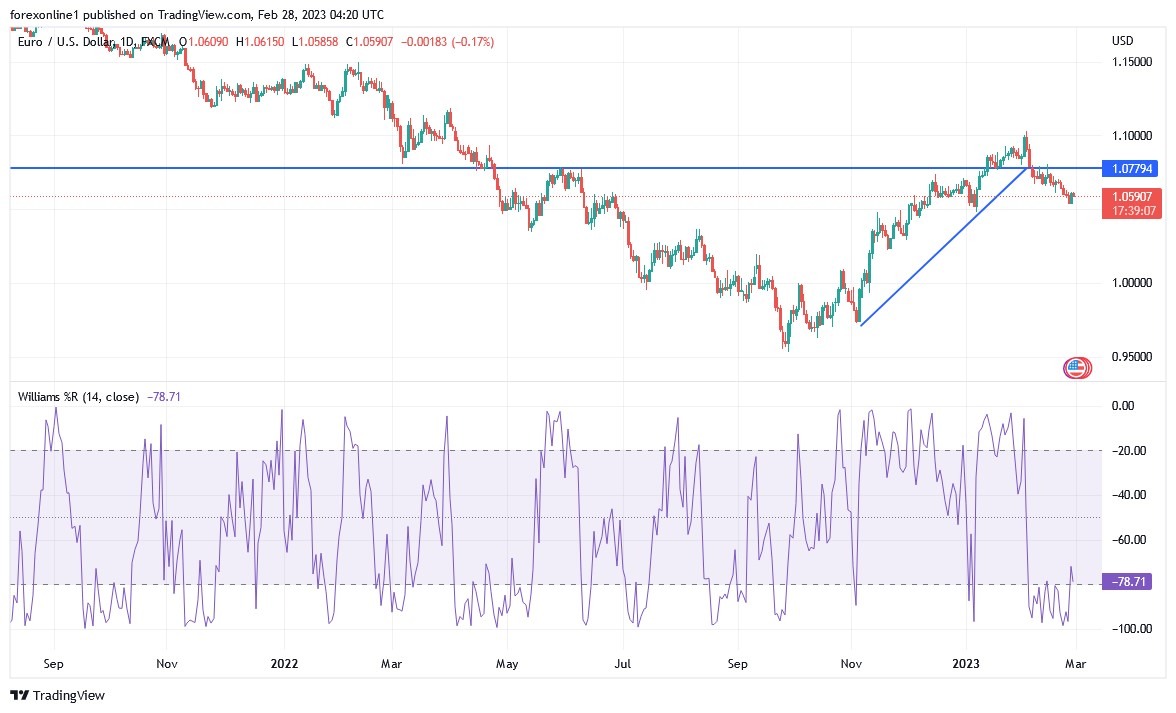The EUR/USD exchange rate entered the new week's trading in search of a foothold near its lows in 2023. However, at risk of a deeper corrective setback after the big gains for the dollar, this is likely to keep many currencies on the defensive in the coming days.
In yesterday's Monday session, the exchange rate of the euro currency pair against the US dollar, EUR/USD, stabilized in a range between the support level of 1.0533 and the level of 1.0620, before settling around the level of 1.0590 at the time of writing.
Overall, the European single currency came under pressure last week as the US dollar extended its recent gains against almost all currencies in response to fresh signs that inflation risks in the US remain to the upside. This is another tailwind to the implied expectations. in the market regarding the US interest rate.
The euro is still holding up better than many other currencies, however, another downward revision to official estimates of German GDP in the fourth quarter was not enough to deter its resilience on Friday.
It will remain to be seen if EUR/USD holds up.
EUR/USD was able to outperform an underlying risk event in this week's calendar. Commenting on the performance, Ulrich Leuchtmann, Head of Forex Research at Commerzbank, says: “The forex market is slowly priced in with the realization that inflationary pressures in western industrialized countries (here: the US and the eurozone) are more persistent than market participants had previously expected.”
“This is positive for the US dollar because the Fed is seen as more ‘proactive’ compared to the European Central Bank. Therefore, the levels of the euro against the US dollar have not (so far) been stabilized around 1.10 in a sustainable manner.” According to the analyst's expectations, the EUR/USD currency pair could struggle to maintain itself above the level of 1.06 in the coming months.
The dollar was bought aggressively on Friday as momentum accelerated after the Bureau of Economic Analysis said the core US personal consumption expenditures (PCE) price index inflation rate rose 0.6% in January, up from 0.4% previously. Friday's January increase in the Fed's preferred measure of inflation follows other figures that suggest price pressures are starting to build up within corporate supply chains again in the new year and keep the market focused on upside risks in the fed funds rate.
This is particularly the case when combined with other generally resilient economic data coming from the US, which has boosted the US dollar in recent trade and could continue to have negative implications for EUR/USD in the coming days. Lee Hardman, Senior FX Analyst at MUFG says “We are keeping the idea of trading short EUR/USD. The pair once again broke below the 1.06000 level during the past week and we expect it to decline towards the support from the 200-day moving average which comes at around 1.0330.”
The analyst added, “The higher movement was in the US yields than it was in the Euro. The price action also highlights that the interest rate market in the Eurozone and the Euro have already moved a long way at the beginning of this year to reflect better than expected. This is according to the cyclical expectations in the euro area.”
While many analysts maintain a cautious view of EUR/USD, there will be upside risks this week if February's inflation numbers go the wrong way for European Central Bank (ECB) policymakers hoping to see price growth return to more consistent levels with a 2% target. The consensus among economists indicates that European inflation fell from 8.6% to 8.4% in February but remained unchanged at 5.3% when energy and food were removed from the basket of commodities being priced.
An unchanged fundamental reading is likely to keep the ECB's interest rate outlook bullish and support the euro, but a lot about this week will also depend this week on the outcome and repercussions of multiple event risks in the US.
Euro predictions against the dollar today:
- According to the performance on the daily chart, the general trend of the EUR/USD currency pair is still bearish.
- There will be no reversal of the current trend view without moving towards the resistance levels 1.0700 and 1.0845, respectively.
- On the other hand, and for the same period of time, the move down will support the next most important support level 1.0475, January 2023 support, which moved the technical indicators towards strong oversold levels.
- Today, the currency pair will be affected by the release of the US Consumer Confidence reading.
Ready to trade our daily Forex analysis? We’ve made a list of the best brokers to trade Forex worth using.


